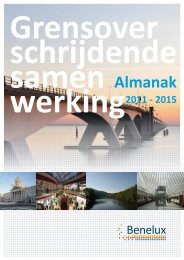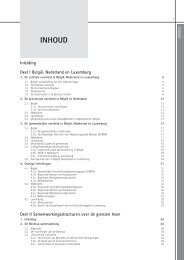The North Seas Countries' Offshore Grid Initiative - Initial ... - Benelux
The North Seas Countries' Offshore Grid Initiative - Initial ... - Benelux
The North Seas Countries' Offshore Grid Initiative - Initial ... - Benelux
Create successful ePaper yourself
Turn your PDF publications into a flip-book with our unique Google optimized e-Paper software.
connected directly to the shore. One German offshore wind farm is connected to the<br />
Danish system – see country specific comments on Denmark.<br />
A comparison of the radial and meshed network design configurations shows no large<br />
differences. For this reason the impact on the German transmission grid is similar and<br />
therefore the assessment of these two grid configurations can be merged.<br />
In order to connect the developed offshore-grid as well as the offshore-windfarms to the<br />
existing German transmission grid, different onshore substations are chosen as follows:<br />
Diele,<br />
Elsfleth/West and<br />
Büttel.<br />
In both grid configurations the offshore wind farms BorWin 2,5 and HelWin 1,2 are<br />
connected to the substations Diele and Büttel.<br />
Specific comments relating to existing national plans<br />
<strong>The</strong> German <strong>Grid</strong> Development Plan [24] is based on results of the national investigations<br />
made in parallel to the NSCOGI study, during 2012. <strong>The</strong> German plan covers the time<br />
between 2012 to 2032 and includes lines which are part of the NSCOGI starting point,<br />
(compare Figure 3-7 ).<br />
<strong>The</strong> national plan found that, in order to achieve the targets of the German energy policy –<br />
especially the nuclear phase out until 2022 and the changeover to renewable energies –<br />
additional grid reinforcements are necessary. A significant impact is caused by the high<br />
increase of onshore and offshore wind farms in the <strong>North</strong> of Germany and solar power in<br />
the South of Germany. This results in high energy <strong>North</strong>-South transmission corridors (e.g.<br />
HVDC) which connect the wind farms in the <strong>North</strong> with the consumption centres in the Mid<br />
and South of Germany and further onwards to the pump storage facilities in the Alps. A<br />
transmission capacity of approximately 26-28 GW is intended for these four corridors.<br />
A big part of these investments are already planned until the year 2020, as shown in the<br />
TYNDP [3] and Figure 3-7 respectively. Although the new connections of the German grid<br />
development plan 2012 are not shown on the NSCOGI-maps, the NSCOGI study confirmed<br />
their necessity. <strong>The</strong>ir invisibility on the NSCOGI maps results from the fact that the<br />
NSCOGI study-process stopped after the first iteration, (see Figure 2-1).<br />
RES+ commentary<br />
For the RES+ Scenario an installed offshore capacity of 25000 MW is assumed. Due to this<br />
increase of renewable energy, further German onshore connection points are necessary in<br />
both grid configurations, not only in order to connect additional wind farms, but also to<br />
implement additional interconnectors. Following this in the meshed grid design, German<br />
and Great Britain offshore wind farms are linked and are connected to Norway. As a<br />
consequence these three countries are linked in a meshed grid structure.<br />
In comparison to the Reference Scenario, the following additional onshore connections<br />
points are chosen:<br />
Page7-42










